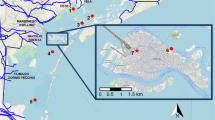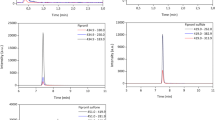Abstract
A new analytical procedure is proposed for monitoring nicosulfuron (sulfonylurea herbicide) in aquatic mesocosms derived from complex ecosystems. The approach is based on alternate use of the anionic and molecular forms of the pesticide during the procedure. It also takes into account the sensitivity of the molecule to hydrolysis. The procedure involves solid-phase extraction on a polystyrene–divinylbenzene support followed by a conventional high-performance liquid chromatographic analysis with UV-diode array detection. Recovery tests on samples from natural waters demonstrated that the performances obtained were convenient for monitoring aquatic mesocosms (recoveries of 91±12% at 0.5 μg L−1). The method was used to monitor nicosulfuron in mesocosms initially spiked at 2 or 30 μg L−1 . The evolution curves were compared to those obtained from mesocosms contaminated with atrazine at the same initial doses. The sensitivity of phytoplankton communities to nicosulfuron in aquatic mesocosms was found to be very limited.






Similar content being viewed by others
References
Beyer EM, Duffy MJ, Hay JV, Schlueter DD (1987) In: Kearney PC, Kaufman DD (eds) Herbicides: chemistry, degradation and mode of action, vol 3. Marcel Dekker, NY, pp117–189
Solomon KR, Baker DB, Richards RP, Dixon KR, Klaine SJ, La Point TW, Kendall RJ, Weisskopf CP, Giddings JM, Giesy JP, Hall LW, Williams WM (1996) Environ Toxicol Chem 15:31–76
Brown HM (1990) Pestic Sci 29:263–281
Bailey JA, Kapusta G (1993) Weed Technol 7:740–745
Fletcher JS, Pfleeger TG, Ratsch HC (1993) Environ Sci Technol 27:2250–2252
Afyuni MM, Wagger MG, Leidy RB (1997) J Environ Qual 26:1318–1326
Gonzalez JM, Ukrainczyk L (1996) J Environ Qual 25:1186–1192
Bry C (2001) In: Neveu A (ed) L’eau dans l’espace rural, tome 2: vie et milieu aquatique, INRA Publications, Paris, pp233–254
Tomlin C (1994) The pesticide manual, 10th edn. British Crop Protection Council, Farnham, UK
Scott MT (1998) In: Roberts TR (ed) Metabolic pathways of agrochemicals Part I: herbicides and plant growth regulators, The Royal Society of Chemistry, Cambridge, UK, pp529–532
Matchett WH, Winnik W, Betowski LO, Brumley WC (1997) Electrophoresis 18:205–213
Krynitsky AJ (1997) J Assoc Off Anal Chem Int 80:392–400
Menne HJ, Janowitz K, Berger BM (1999) J Assoc Off Anal Chem Int 82:1534–1541
Hickes H, Watrous M (1999) J Assoc Off Anal Chem Int 82:1523–1533
Shalaby LM, Bramble FQ Jr, Lee PW (1992) J Agric Food Chem 40:513–517
Rodriguez M, Orescan DB (1998) Anal Chem 70:2710–2717
Furlong ED, Burkhardt MR, Gates PM, Werner SL, Battaglin WA (2000) Sci Total Environ 248:135–146
Li LYT, Campbell DA, Bennett PK, Henion J (1996) Anal Chem 68:3397–3404
Nilvé G, Knutsson M, Jönsson JÅ (1994) J Chromatogr 688:75–82
Galletti GC, Bonetti A, Dinelli G (1995) J Chromatogr A 692:27–37
Powley CR, De Bernard PA (1998) J Agric Food Chem 46:514–519
Seguin F, Leboulanger C, Rimet F, Druart JC, Bérard A (2001) Arch Environ Contam Toxicol 40:198–208
Seguin F, Le Bihan F, Leboulanger C, Bérard A (2002) Water Res 36:3227–3236
Seguin F (2001) Effets comparés de deux herbicides l’atrazine et le nicosulfuron, sur un écosystème aquatique expérimental. Doctoral thesis, University Toulouse III, 188pp
Sabadie J (2002) J Agric Food Chem 50:526–531
Acknowledgements
INRA and French Environment Ministry are acknowledged for financial support (PNETOX A00873).
Author information
Authors and Affiliations
Corresponding author
Rights and permissions
About this article
Cite this article
Nélieu, S., Perreau, F., Guichon, R. et al. Monitoring and effects of nicosulfuron in aquatic mesocosms: development of a simple analytical procedure and evidence for low toxicity to phytoplankton communities. Anal Bioanal Chem 382, 108–114 (2005). https://doi.org/10.1007/s00216-005-3190-8
Received:
Revised:
Accepted:
Published:
Issue Date:
DOI: https://doi.org/10.1007/s00216-005-3190-8




